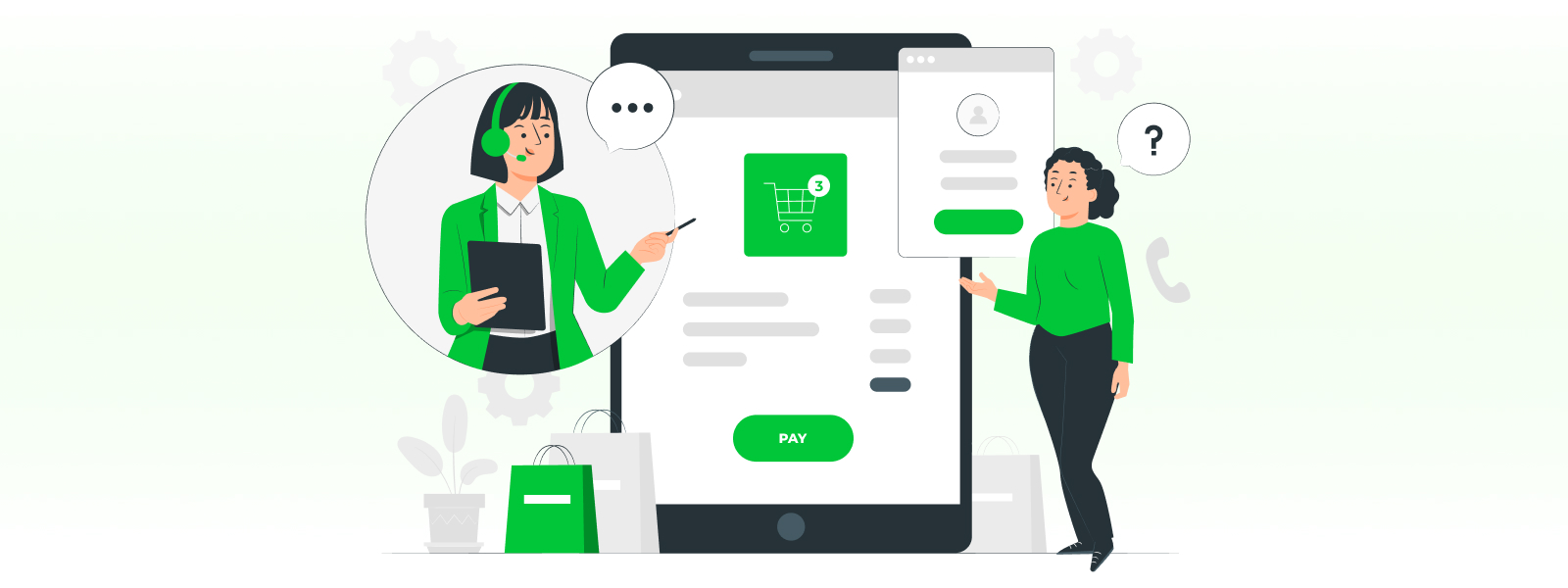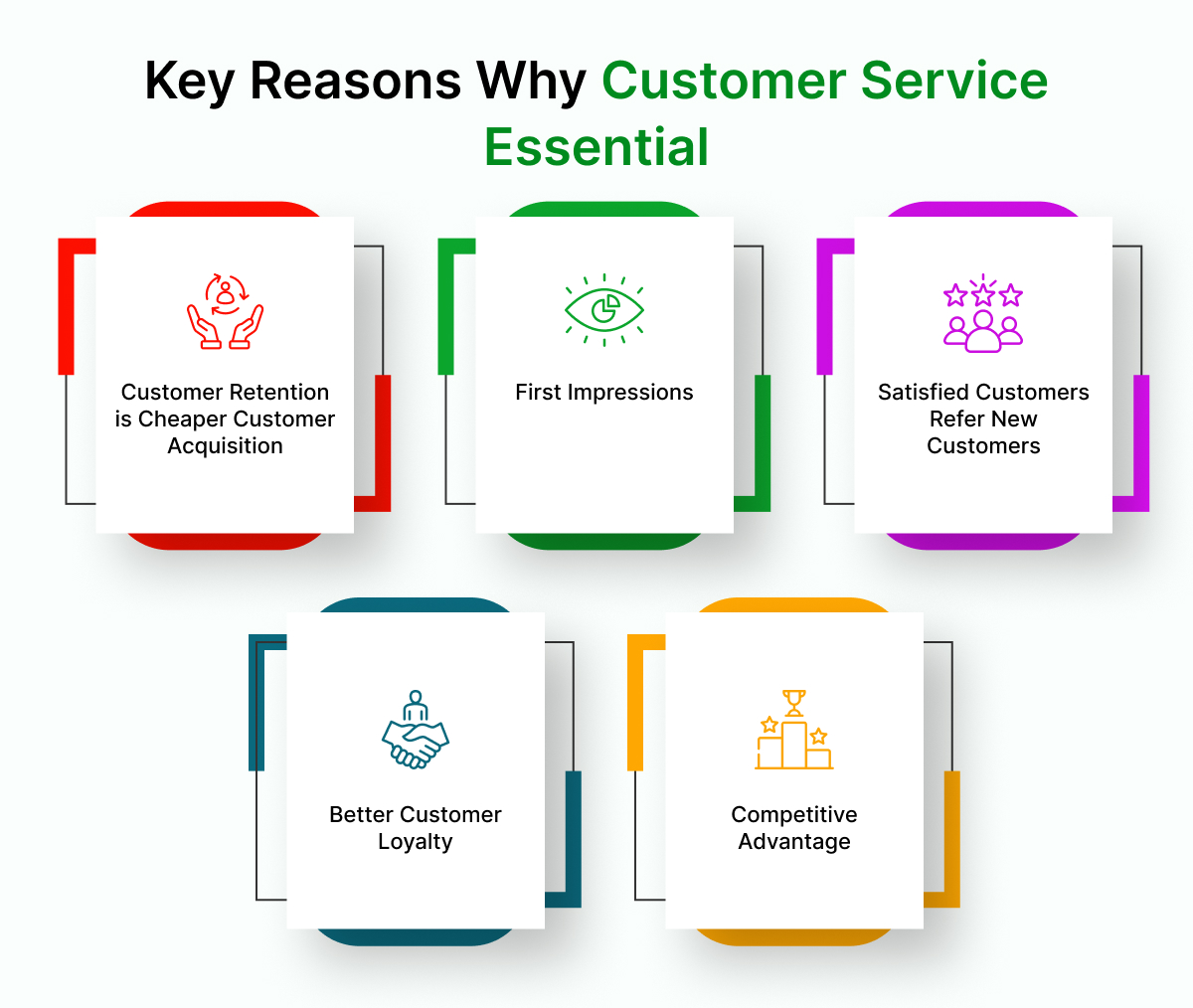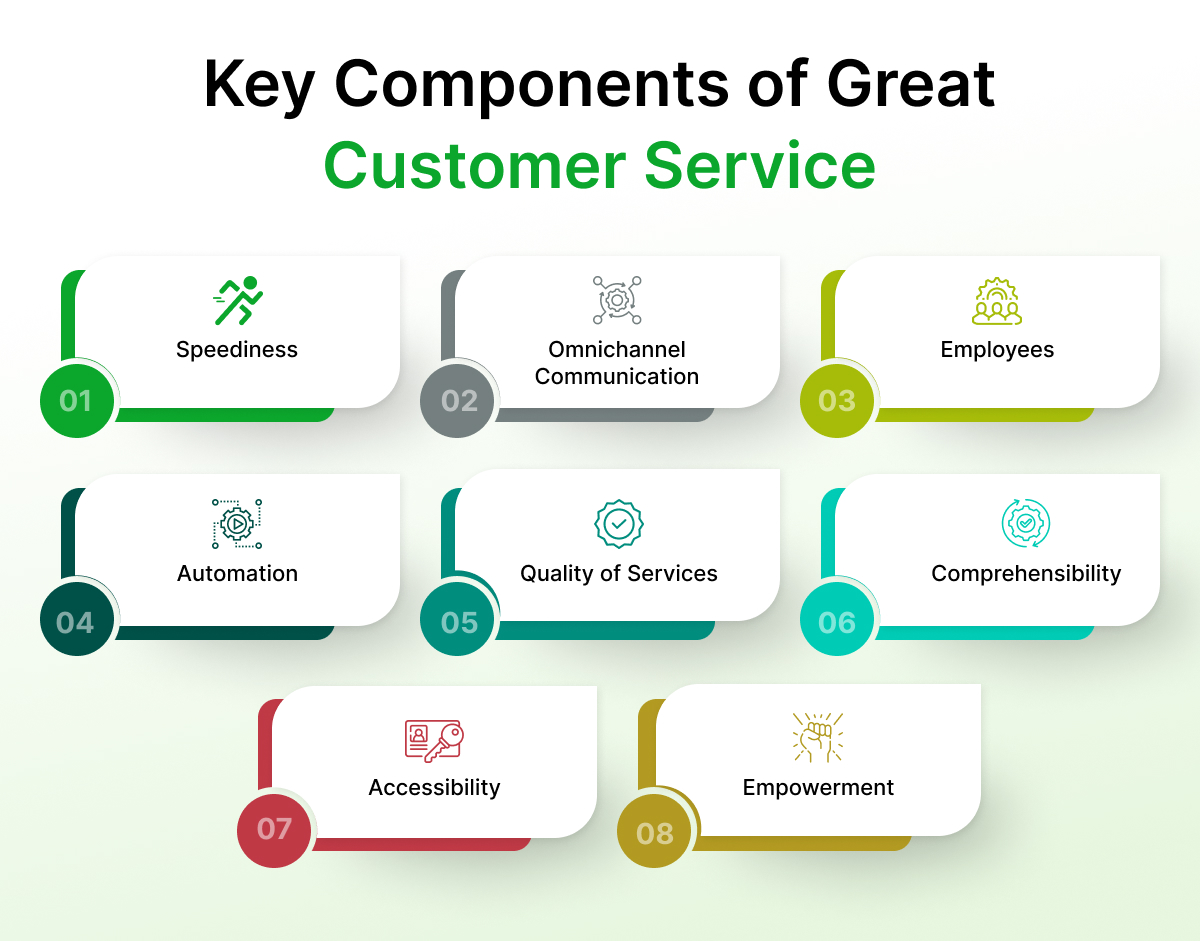 Customer Service
Customer Service

04 March, 2023

Exceptional customer service practices– it’s more than just a theory, and businesses should rely on it for the sake of reputation. Whether you’re running a small business or a global corporation, customer service can mean the fine line between success and failure.
If you’ve had customer service practices on the back burner for a while, now is a great time to get started. And here’s why:
But it’s alright if you still haven’t rounded up a well-thought strategy.
In this guide, we’ll unpack everything you need to know about elevating your business.
Contents
Almost everyone can recall a bad customer service experience. Sharing experiences is one of the vital customer service statistics. On average, happy customers refer your business to nine people, whereas angry customers tell sixteen. That’s a big difference and a hefty price to pay in the long run.
So what is an excellent customer service practice?
Excellent customer service means the following practices:
The longevity of your brand depends on the integration of customer service practices. Businesses today can’t afford poor or mediocre practices in their regimen. According to Salesforce Research, if a company’s service is immaculate, nearly 80% will choose the business even if they committed a mistake before.
Further, 93% of consumers are likely to repeat purchases from companies that implement excellent customer service practices from the get-go.
But that’s not only why it matters. Perfect customer service has many benefits that play critical roles in every aspect of your business. From customer acquisition to getting reliable feedback and competitive advantages.

Here’s how good customer service delights your business every time:
Did you know keeping existing customers is cheaper than hunting for new ones? Yet it doesn’t mean your search for an acquisition quest should end.
However, it’s worth mentioning that customer retention is far more affordable. In fact, studies show that the budget for new customer acquisition is between 5-25 times more expensive than retaining existing ones.
This happens because keeping current customers happy and pleased is less expensive than chasing new ones, and exceptional customer service is the basis for that pleasure.
No matter what industry you are in, first impressions matter. And if a part of that perception is poor customer service practices- your company’s in trouble.
Customer service practices are a big piece of your branding puzzle. A company with first-rated services receives a branding boost through social media or customer reviews. These data will act as testimonials and interpret your company’s outlook on customer satisfaction.
Wouldn’t it be great to earn new customers for your business without expensive marketing or acquisition budgets? Word of mouth or referrals can just do that for your business.
Happy customers who feel valued and appreciated are likelier to refer other customers to you. According to Qualtrics XM Institute, good customer service practices heavily impact recommendations.
In other words, the more you invest in exceptional CX for your current customers, the more you’ll get referred.
Customers are savvy and won’t settle for brands that don’t meet their expectations. People are loyal to brands that change with them proactively and prefer companies that try to understand them. About 96% of customers say that customer service plays a significant role in their decision to remain loyal to a brand.
Companies can deliver superior products but are willing to walk out without premium services.
Usually, clients will refuse to work with companies after one bad experience. If your competitors are doing it better, make sure you are taking the necessary steps to retain your existing customers.
With that being said, you can see how coherent and consistent customer assistance can make all the difference.

Your customers can distinguish between subpar and superior services. So, implementing excellent customer service practices isn’t something you can fake.
If you’re not sure where to start, consider this list to help with your program:
There’s no denying speed is one of the vital elements of customer service practices. The thought of being crammed in a queue is enough to break us out into a cold sweat.
Ever-accelerating technology has reduced our patience span, and customer service is no different.
The speediness of your service depends on:
Phone waiting lines are sometimes frustrating because they leave customers in limbo. And emails could take days to be answered. This is why you must choose the trending communication channels for smooth and convenient communication.
Fast communication channels are of no use if you have staggering employees. So, it’s essential businesses use prompt and proactive employees. Training on areas like, time management, communication, and negotiation can do the trick.
No one, we repeat, no one likes loitering businesses. Today, people are looking for instant service. Whether it’s a live chat or information transfer, automation makes the process smoother.
When Amazon charged a customer $7000 for toilet paper, it generated a negative review in the public press. Everyone now thinks twice before making a purchase from that store.
This is what happens when you have poor service quality. Ideally, continual training should be offered to implement a robust customer service practice.
If there’s a surefire way to alienate your customers, it’s the technical talks and jargon. Whenever a customer walks in with a problem, you cannot dive into the mechanism of the product. They need solutions, and you must deliver them clearly.
A classic example is the terms and conditions agreement. Most people don’t read them due to their sentence structure or length. A good customer service practice is making the sentences smaller and more digestible for all.
This element is about how accessible you are to your customers across different touch points.
Slow websites + poor navigation = unfriendly websites.
If your website is laggy with a poor navigation system, customers will give up on the site for your competitors.
Your website is a virtual storefront. It’s the first point of contact for new customers, so it should be:
Remember you have 50 milliseconds to make a first good impression. Make sure your website helps!
For most customers, live chat is their preferred support platform for voicing their concerns. Compared to other channels like call centers, live chat is fast, allows multitasking, and the conversation can be saved for later.
Apart from all these features, live chat proves to be a potent selling tool.
Here are some of the best live chat practices:
Your customers will likely have questions outside office hours, especially when you have clients globally. Being available 24/7 is a good customer service practice. Automation can go a long way if you can’t be available 24/7,
Customers want to feel empowered. Nothing leaves us feeling more helpless than inflexible policies and bureaucratic loops.
showcases your company’s compassion and gives customers reasons to trust your brand. However, most organizations do not provide flexibility for refunds or little leeway.
Most customers want to be independent and help themselves. Options on the website like FAQs or insightful knowledge blogs can answer necessary queries about your services without communication assistance.
Being able to give reviews or feedback is integral to feeling empowered. If your clients have faced poor service, let them express it. Once they have pointed out the issues, you can work on them.
Here are some of the customer service practices you can use to delight your clients and have them raving about your business:
The leading brands build a customer-centric culture driven from the top down.
In other words, a customer service team doesn’t operate in a vacuum. It needs customer service practices that feature a well-rounded strategy.
Whether it’s a tier-one SDR answering the easiest questions to the CEO guiding the business every employee needs to structure their work direction based on customer satisfaction. This starts by constructing a reliable hiring plan, one that will identify which candidates will embrace your customer-centric culture.
Are they customer-focused and patient? Are they good listeners? Do they use friendly language while dealing with queries? Asking the right questions during screening employees can go a long way in establishing a customer-focused culture.
One of the vital customer service practices is knowing your product thoroughly. As a customer support agent, you spend all day troubleshooting products. And that means you have to be a product expert.
Your job is to make clients confident about their purchases and feel like they have gotten the true value for their money. Make it a mandate to learn about your products and services to amaze your customers with timely recommendations for using new features.
Attitude is everything when you are making sales. The right attitude changes negative customer experiences into positive responses.
Sadly, we heavily rely on digital communication platforms, and the tone of emails or live chat can seem cold. So, don’t be afraid to add humor and warmth to the exchanges. Add emojis to elevate the emotion. Pick up the phone if the conversation gets tense. Professionalism is a myth.
Creating a nice experience for everyone is NICE. However, from a loyalty standpoint, there’s something more essential: reducing customer efforts.
An average customer service practice would be just explaining what the customer needs to do and having them do it. An excellent customer service practice would be if a customer needs to resolve their issue, you will do it for them.
Don’t make your clients chase the solutions. Take the extra mile and ensure they do as little as possible. You can delight them and create a positive brand identity by taking the work off their plate.
There’s a but here. If the task is simple or recurring, explain the process instead of getting in.
Nobody needs a reason to say Thank You.
The power of this beautiful phrase is unmatched. Receiving gratitude doesn’t just change we think and feel; it changes how we behave.
Did they complain? Say thank you! Did they report a bug? Say thank you!
You also don’t need a reason to apologize. When a customer gets angry, you give a refund. But don’t forget the value of a single apology. When businesses add apology over compensation, satisfaction increases by 74%.
40% of customers say they want better human services. It doesn’t mean most companies alienate their clients.
However, clients want to feel like more than just a lottery ticket. They get angry when they are not treated right or batted like a tennis ball from department to department.
Customers want to interact with a person, not the entire company. Customizing your services is a vital practice that lets customers understand you care.
Did you know 81% of customers attempt to resolve issues before contacting a representative? Customers don’t always want to talk about their problems with support agents. Most times they want to settle the issue themselves.
So, integrating the self-service practice is a scalable and cost-effective way to make clients happy. And, if they can’t resolve their queries, help from companies is just a text away.
If there’s something the pandemic taught us, it’s that agility is key. And champions lead on customer-centric agility.
This involves analyzing customer data, feedback, and market research and then acting according to those insights. Flexible businesses change towards the aspects customers want and expel processes customers don’t need.
Etsy is one of the examples that implements agility as a customer service practice. With a shortage of face masks during the pandemic, Etsy sellers pivoted instantly and manufactured various face coverings. Sellers on the platform weren’t worried about the sudden drop in sales because the demand for masks was overwhelming.
Delivering a quality service is impossible without a quality tech stack. The tech stack can do wonders for a business from AI chatbots to streamlining the entire process. These technologies free the customer support team from menial tasks, which means more time to provide the white-glove customer service that clients remember.
Sounds creepy, right?
It’s easy to let angry customers leave your business after they are upset. If they’re gone, they’re gone, right?
Remember the stats we read earlier? A bad customer experience will eventually result in no customers at all. So it’s imperative you remain calm and listen. Ask questions, clarify, and flesh out what their needs are.
You can also follow the simple workflow to turn angry customers into happy customers:
Resolution time is an important KPI that determines the efficiency of your support team.
A customer service benchmark study by SuperOffice showed that 62% of consumers reported they had to contact companies to resolve their issues repeatedly. And over 65% of those customers were ready to share their harrowing experiences over social media. The study also showed only a meager 20% of companies resolved clients’ queries on the first attempt. If you’re among this minority, bravo!
However, if you are struggling to deliver speedy services, here are some pointers to help:
Meeting customers’ expectations are cool, but exceeding them? Now that’s an experience your customers won’t forget. Small acts of kindness and consideration will not only win you brownie points with the customer but win some love on social media.
Here are ways you can incorporate the practice into your customer service checklist:

In the B2B industry, stellar customer service is essential because:
Here’s what a standard B2B customer service practice looks like
The B2B industry is different. As lovely as it can feel to give immediate responses, it’s meaningless unless the answer has a resolution. One million quick responses still add up to a lot of time without a solution. So, focus your energy on getting appropriate answers rather than immediate answers.
Unlike B2C, automation and bots don’t reign here. In B2B, the people you are interacting will want a human connection. In fact, 75% of customers still choose to interact with people, even if automation exists.
The reason is that humans are empathetic and capable of understanding people around them. Robots, while efficient, lack the human touch.
Yes, B2B customer support is usually high touch. But it doesn’t always have to be this way.
Most of your customer queries are actually simple– resetting passwords, changing basic settings, billing issues, adding/deleting users, etc. Ideally, most organizations are staffed with technical experts to handle these simple tasks. However, customer self-service options like knowledge base, FAQ sections, chatbots, and community forums.
A well-written knowledge base of how-to videos, basic troubleshooting, and FAQs can take the load off your team. This can give them ample time to handle complex queries.
When customers share valuable insights from NPS or CSAT surveys, how do you respond? Some companies might roll their eyes at the comments and deem them ridiculous or out of scope. But even the weird comments are worthy of your attention.
Did you know 77% of consumers feel more favorably if an organization actively considers their feedback?
Instead of rolling your eyes at the feedback, try to understand where this is coming from. Even the wildest requests have roots in reality, especially in the B2B industry. So take the time to dig in and understand the core behind the problems.
SLAs or Service Level Agreements define the quality or level of service vendors deliver. It is a critical component of the client-vendor contract.
In the B2B domain, not all companies are treated equally. Some clients have more complex requirements than others. While it’s not right to let one business cut in line and get ahead of another, it’s acceptable to prioritize your support queue. The prioritization can be done via SLAs. SLAs can help you prioritize the customer support queue based on:
All elements above combine to produce top-notch customer service practices for your business. And it’s great since it keeps your customers loyal to you and your business. Customers want to be treated like humans, not a number in a lottery queue. So humanize the process and aim for service-driven growth.